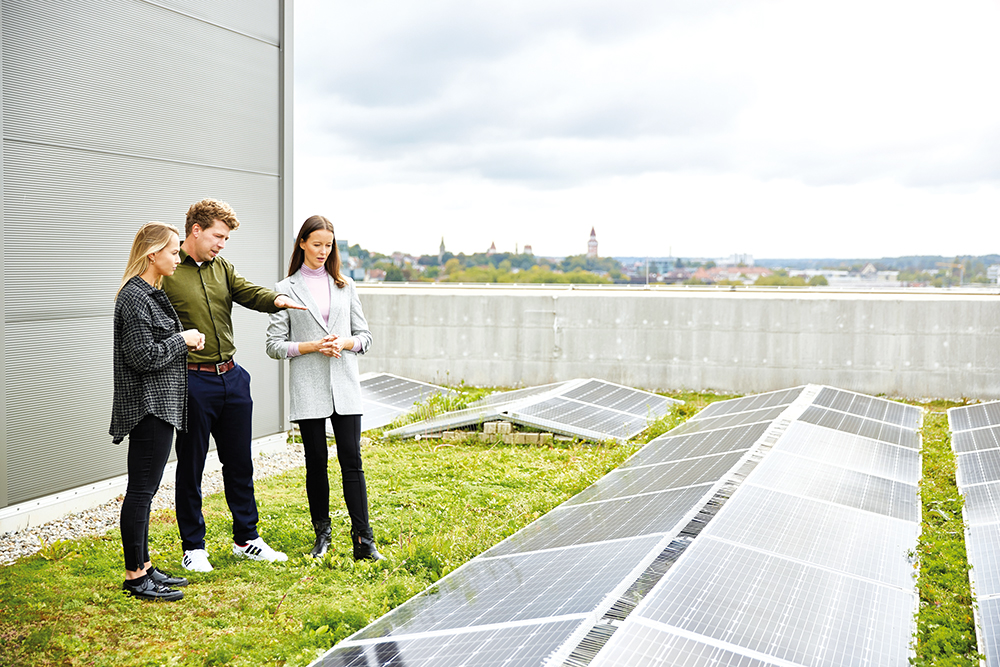To Issue 153
Citation: Badack H, “Tips and Tricks for Implementing Sustainability Initiatives”. ONdrugDelivery, Issue 153 (Oct/Nov 2023), pp 42–44.
Henryk Badack outlines Vetter‘s efforts to establish sustainable business practices.
“Companies must go beyond minimising their carbon footprint… they must also seek to find a balance between the three pillars of ecological, economic and social impact.”
Achieving sustainable business practices in the pharmaceutical and biotech industry is no easy feat. Through trials across its 70+ year history in the industry, Vetter has established proven processes to activate meaningful and authentic sustainability initiatives and projects.
Vetter’s 2022 Sustainability Report outlines the company’s commitment to integrating sustainability into its growth worldwide. This is proven through the steps the company takes to make lasting and vital change in line with the needs of the world and society. For example, Vetter joined more than 300 other pharma companies in signing the UN Global Compact – a pledge to align itself with the UN Sustainable Development Goals through sustainable and responsible corporate governance.
To adequately achieve a steady dedication to acting sustainably, companies must go beyond minimising their carbon footprint, although this remains important. They must also seek to find a balance between the three pillars of ecological, economic and social impact. Only then can organisations truly achieve sustainable business practices that support their growth, the success of their customers and the betterment of society as a whole.
As a contract development and manufacturing organisation (CDMO), Vetter serves as a partner to pharma and biotech companies of all sizes and scopes. As such, the organisation wants to lead by example and set the standard for what it hopes all others in the industry can achieve with regards to a daily commitment to sustainability.
THE “WHY” BEHIND THE EFFORT
To integrate sustainability wholeheartedly into everyday business practices, it must be done as a core foundation of an organisation. There are those who follow the regulations and requirements of sustainable practices, but there are also those who truly want to lead in the space because it aligns with their own company values. With the incorporation of its environment, health and safety management system and the documented transparency of its successes and hurdles, Vetter established steps early on to guide its growth in sustainability. European companies are also obligated to observe the “Green Deal” initiated by the EU, which sets a goal to be the world’s first climate-neutral continent by 2050. This will be achieved by reducing greenhouse gas emissions by more than half by 2030, and the industry must make changes to contribute to this goal successfully.
Since biopharma companies cannot expect to emit no CO2 due to strictly binding regulatory requirements, Vetter chose to put in effort in other ways to offset this unavoidable emission.
When sustainability is woven into everything a company does, it has its own strategic benefits. For example, the past three years since the start of the global pandemic have highlighted how fragile the supply chain can be. When new bottlenecks arise along the supply chain, it can have negative implications on patients in need receiving the medications they so desperately rely on. Vetter took steps to incorporate sustainability despite other external challenges that it faced and, as a result, has built a capacity for resilience to disruptions along the supply chain.
As customer demands increase and patient needs remain high, it is the company’s responsibility to find solutions to overcome outside obstacles and continue to meet the timelines it has outlined with its customers. By finding solutions to avoid dependency on one supply chain partner, Vetter has grown through the challenges and come out on the other side stronger.
“Through years of investment, Vetter has optimised its existing
systems, built new, energy-efficient construction and focused on the generation of renewable energy.”
FROM CONCEPT TO REALITY
Vetter has been conceptualising and putting into practise an environment, health and safety management system for over a decade. One result has been carbon neutrality across all Vetter sites since 2021. However, this did not happen overnight. Rather, it took an extensive and fully integrated commitment to enhance efficiency through technological adjustments, offsetting where needed, and shifting the company-wide mindset to one led with sustainability in mind. The real challenge comes when trying to measure success and make changes based on lessons learned.
Vetter published its first ever sustainability report in 2022, guided by the requirements of the German Sustainability Code and the Sustainability Report Standards of the Global Reporting Initiative. The report not only acknowledges the company’s progress and successes but holds it accountable to achieving its goals. With these outward-facing commitments made in writing, Vetter is holding its feet to the fire to reach its sustainable goals in the timelines it has proposed. As a family owned company, this is not just to improve the outputs for customers and patients, but to leave a legacy the organisation can be proud of for many generations to come.
In an industry with particularly high carbon emissions, how did Vetter become a leader in sustainable growth?
The company established an independent sustainability management system that supports, tracks and measures all related projects. By documenting its progress, the company can accurately identify areas of success and areas for improvement to constantly evolve its practices for the greatest impact. This is a top-down commitment with a clear trickle-down effect as the owner family and managing directors recognise the great importance of sustainability and fully support the strategies as driving forces behind the overall business strategy.
In addition, Vetter established a sustainability core team to keep a finger on the pulse related to industry-wide trends, and to keep the organisation on track to achieving the goals expressed in its annual sustainability update.
HONING A PATH FORWARD
As a highly technical pharma service provider, Vetter requires special production conditions and must adhere to strict regulatory requirements from various authorities. However, that does not make it impossible for the company to find ways to make its production sites more environmentally friendly. Instead of changing extremely precise processes, it focused on adjusting its technical infrastructure outside of its pharma production zones.
Through years of investment, Vetter has optimised its existing systems, built new, energy-efficient construction and focused on the generation of renewable energy. One area of success has been its water-for-injection recirculation system, which has allowed it to save 47,196 kWh of electricity, 13,452 kWh of gas and 1,562.5 m3 of water each year. By using direct current electric motors in its ventilation systems, it can replace the alternating current electric motors with a more energy-efficient alternative. This has saved 1,720 kWh per motor per year, all without jeopardising the quality and control of the cleanroom processes.

Figure 1: The photovoltaic systems on Vetter production facilities.
Another way Vetter has made strides in its sustainable practices has been through the expansion of photovoltaic systems on the roofs and facades of its production sites (Figure 1), as well as through the use of geothermal energy. This allows it to cover its energy requirements through partially self-generated renewable energy. These, and several other sustainability efforts, have spanned an investment of over €7.8 million (£6.8 million) in more than 125 individual projects.

Figure 2: Vetter has on-site bike parks for all employees.
Beyond what many consider the traditional sustainable initiatives, Vetter has also taken a creative approach to achieving sustainability through unique employee programmes, such as its bike-leasing programme, charging stations for electric bikes and cars (Figure 2), enabling remote work to avoid unnecessary commuting and covering the costs of local train tickets for commuters. These efforts are easy to implement and offer high rewards – and can be implemented by any company committed to acting sustainably.
IMPLEMENTING SUSTAINABLE PRACTICES
Establishing sustainable practices for a pharma or biotech company goes far beyond the idea. It must extend into how it is put into practice, measured and reported on and, eventually, improved. By collecting past and current efforts and outcomes and aligning them with strategic goals for the future, companies can create a comprehensive sustainability report to serve as a guide for years to come. Success comes down to the collection and analysis of data and the way this information is used to drive future sustainability commitments.
This will not come without its challenges – many of which Vetter has faced. The production of critical life-saving medications is resource intensive, and manufacturing requires significant energy intensive production infrastructure. While none of this can be jeopardised, there can be workarounds and innovative solutions to help meet sustainability goals without harming the end product – life-saving medications for patients.
Keeping an eye on new opportunities for sustainable growth will keep your company at the forefront of this ever-evolving landscape. As you find new technologies to serve in capacities to reduce fossil fuel resources or other environmentally taxing issues, you can achieve measurable success in sustainability that can be built upon for decades.
The industry’s strength is in numbers – the biopharma sector should combine forces to find new solutions for growth, from sustainable packaging to new technology tools, to maximise flexibility and sustainability while never compromising its work.
The most important element to remember when deciding how to incorporate sustainable business practices into your organisation is that sustainability does not always need to be high tech. Every company must define its own route to sustainable success and must put one foot in front of the other every single day to truly see the impact needed. Sustainable business is a lifetime commitment that must be adhered to without an end date in mind.

